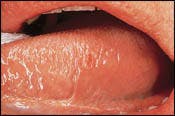Case Study
A 23-year-old male visited a dental office for a routine checkup. During the oral examination, a small red and white area was noted on the tongue.
History
The patient was not aware of the red and white area on his tongue and was uncertain of how long the lesion had been present. The patient denied any recent trauma or thermal injury to the area. No pain, burning, or sensitivity was noted in the affected area.
The patient appeared to be in an overall good state of health. No health problems were noted, and the patient was taking no medications at the time of the dental examination. The patient's past dental history included regular dental examinations and routine dental treatment. The red and white area on the tongue had not been noted at previous appointments.
Examinations
The patient's vital signs were all found to be within normal limits. Examination of the head and neck region revealed no enlarged or palpable lymph nodes. Extraoral examination revealed no significant or unusual findings.
Intraoral examination revealed a small red and white area on the lateral tongue (see photo). Closer examination revealed a red area of atrophied filiform papillae surrounded by white, raised borders in a circinate pattern. Further oral examination revealed no other lesions present.
Clinical diagnosis
Based on the clinical information available, which one of the following is the most likely diagnosis?
- atrophic candidiasis
- reticular lichen planus
- median rhomboid glossitis
- hairy tongue
- benign migratory glossitis
Discussion
Benign migratory glossitis (also known as geographic tongue) is a relatively common lesion of the tongue. The term benign indicates that the lesion is harmless; the term migratory refers to the fact that the lesion moves around; and, the term glossitis refers to the fact that it looks like an inflammation (-itis) of the tongue.
Although the cause of benign migratory glossitis (BMG) is unknown, some investigators have suggested that it occurs with increased frequency in atopic individuals, suggesting that it may occur as a hypersensitivity reaction to an environmental factor.
Clinical features
BMG affects the dorsal and lateral tongue and is seen in 1 to 3 percent of the population. Females are affected more often than males. BMG is characterized by areas of atrophied filiform papillae in an irregular circinate pattern surrounded by a distinct yellowish-white border. The areas lacking filiform papillae appear smooth, shiny, and red and exhibit scattered fungiform papillae. The term geographic tongue has been used to describe the pattern seen on the tongue; the areas lacking papillae are said to resemble "islands in a sea" of normal-appearing tongue mucosa.
Single or multiple areas of the tongue may be affected by BMG. When multiple areas of the tongue are affected, the lesions tend to coalesce and produce large areas of involvement. It is not uncommon to see involvement of the entire dorsal tongue. The lesions of BMG may remain static, or they may change shape and move to other areas of the tongue. The areas lacking papillae typically remain in one location for a short period of time, then resolve and appear in another location, hence the term migratory.
BMG may be seen in association with another condition of the tongue, fissured tongue. At this time, the relationship between the two conditions is unknown.
BMG has a variable duration and may persist for weeks, months, or even years, and then disappear. BMG tends to wax and wane; the pattern is typically one of regression and recurrence for no apparent reason. BMG is usually asymptomatic and noted as an incidental finding during routine oral examination.
In some cases, a patient with BMG may describe a burning sensation, tenderness, or pain associated with the ingestion of acidic or spicy foods. Only in rare instances is the burning constant and severe.
Diagnosis and treatment
The appearance of BMG is characteristic and the diagnosis is made on a clinical basis. A biopsy is rarely required for a definitive diagnosis. Because BMG is a self-limiting condition and is usually asymptomatic, no treatment is required.
If a burning sensation or discomfort exists, empirical treatment to alleviate symptoms is suggested. In symptomatic cases, a topical corticosteroid medication may be helpful.
The patient with BMG should be reassured that the condition is harmless and has no malignant potential.
Joen Iannucci Haring, DDS, MS, is an associate professor of clinical dentistry, Section of Primary Care, The Ohio State University College of Dentistry.

